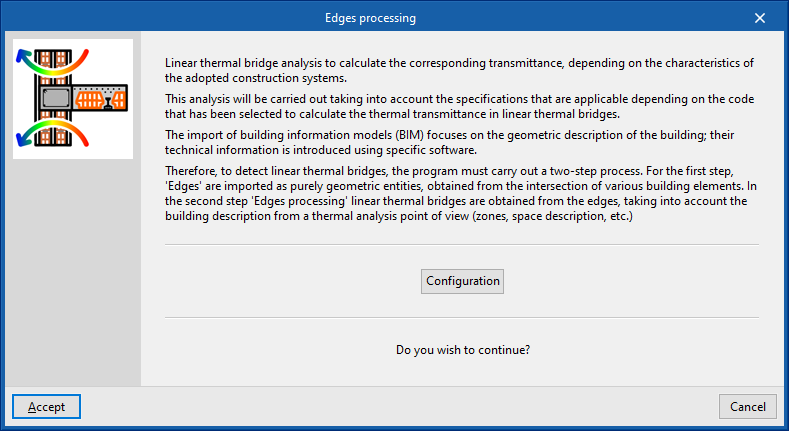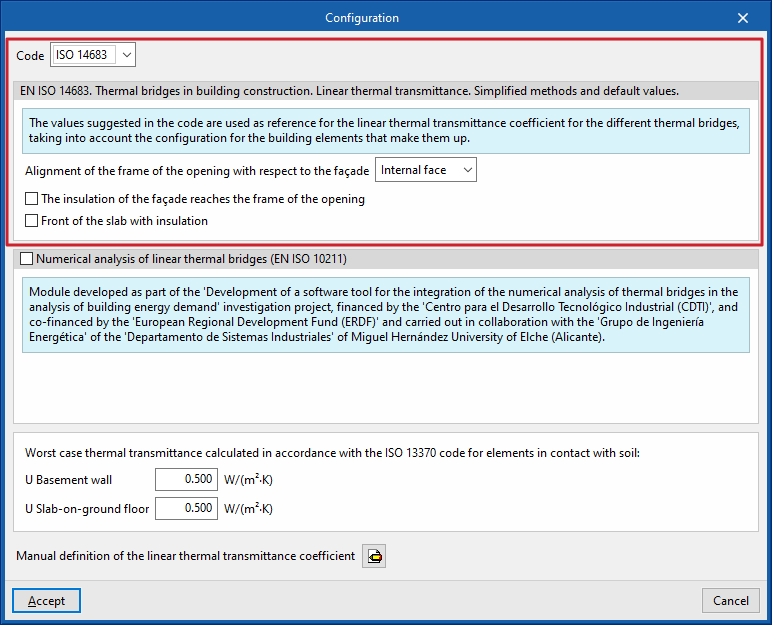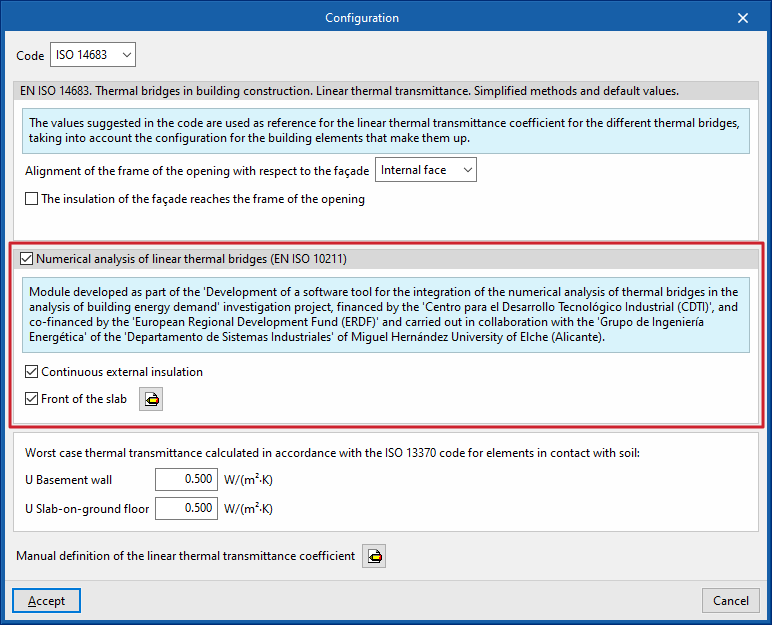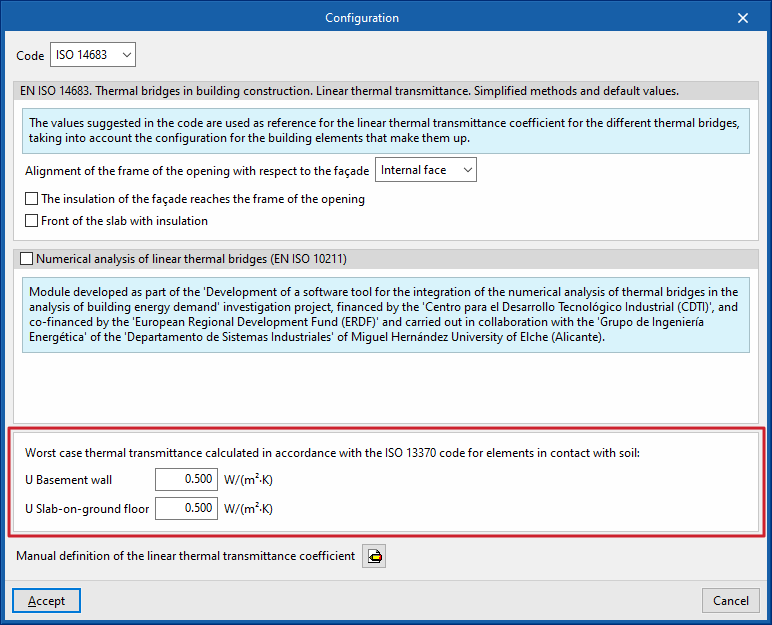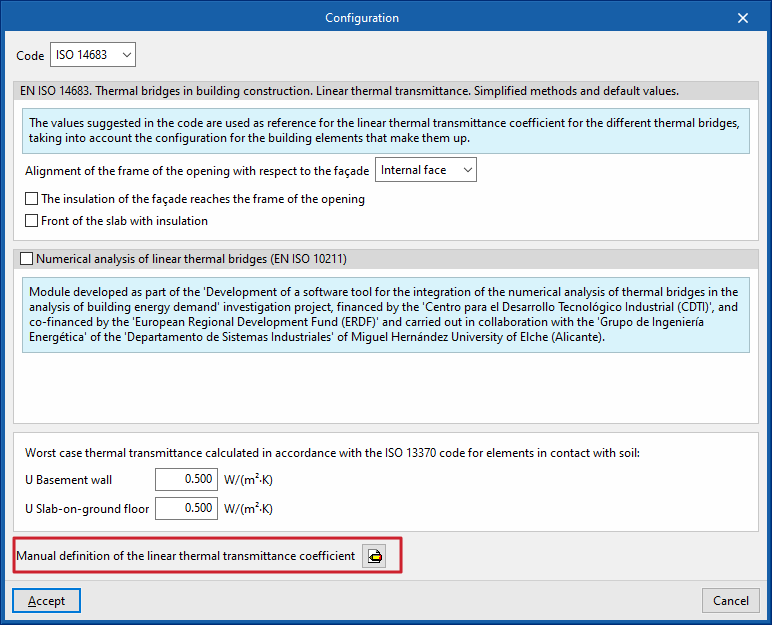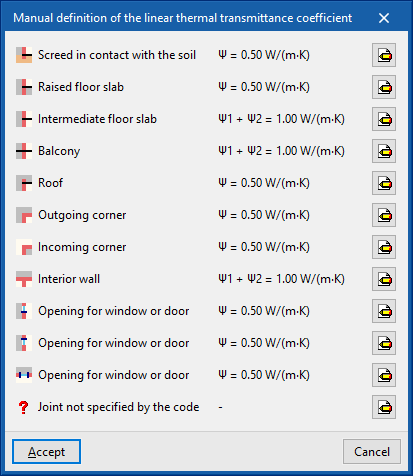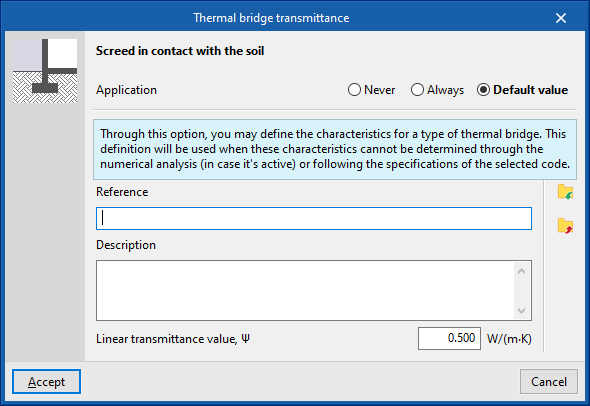Edges processing
The analysis of linear thermal bridges can calculate the corresponding linear thermal transmittances according to the characteristics of the construction systems adopted. This analysis is carried out taking into account the specifications applicable according to the standard selected for the calculation of thermal transmittance in linear thermal bridges.
The import of building information models (BIM) focuses on the geometric description of the building. The technical information is entered into specific programs. Therefore, for detecting linear thermal bridges, the program performs a two-step management:
- In the first stage, the edges of the building are imported as purely geometric entities, obtained from the intersection between different building elements. This is done by generating the building model in the process of importing a BIM model with this information, contained in the BIMserver.center project. In this step, the thermal bridges library contains all edges of the building, as geometrical entities obtained from the intersection between the different building elements. Some of these edges may give rise to linear thermal bridges, so a second step is necessary.
- In the second stage, using edge processing, the linear thermal bridges are obtained from the edges and based on the description of the building from the point of view of thermal analysis (zoning, description of spaces, etc.). The program analyses the building and detects the geometric edges between a habitable room and the outside, and between a habitable room and a non-habitable room. Not all edges can give rise to linear thermal bridges.
This process is carried out by clicking on the "Edges" option in the "BIMserver.center" group in the top toolbar of the "Building" tab. The use of this tool requires that the building is defined without errors:

By accepting the "Edge processing" window, the program modifies the data related to the "Linear thermal bridges" in the side tree of the "Building" tab, both with respect to the library and with respect to the linear thermal bridges assigned to each space in the tree diagram that is displayed by selecting the "Zones" level. Thus, the necessary types are generated and the linear thermal transmittance value and the category associated with each of the linear thermal bridges are adjusted.
Edge processing settings
The program analyses the building by detecting the geometric edges that lie between a habitable space and the outside, and between a habitable space and a non-habitable space. Using the configuration options, the characteristics of the main building solutions are selected so that the corresponding thermal transmittances are analysed.
For this purpose, in the "Edge processing" window which appears when using the "Edges" option, the "Settings" option is used. This option allows the following edge processing parameters to be set:
- Code
- Numerical analysis of linear thermal bridges (EN ISO 10211) (optional)
- Manual definition of the linear thermal transmittance coefficient
The effects of the configuration of these parameter sets are detailed below.
Code selection
The "Standard" drop-down menu is used to select the reference standard for edge processing. Among the available standards are the following:
ISO 14683
The following code can be used as a reference: EN ISO 14683. Thermal bridges in buildings. Linear thermal transmittance. Simplified methods and default values.
The values proposed in this code for the linear thermal transmission coefficient of the different thermal bridges are used as a reference, taking into account the configuration of the building elements it is made up of.
The options available under this code are as follows:
- Alignment of the opening frame to the envelope (To the inside / To the centre / To the outside)
- Insulation of the envelope up to the opening frame (optional)
- Insulated slab front (optional)
Numerical analysis of linear thermal bridges (EN ISO 10211)
The activation of this section determines the thermal transmittance in linear thermal bridges by solving and post-processing a finite element heat transfer analysis model based on EN ISO 10211.
This module is developed as part of the research project "Development of a software tool for the integration of the numerical analysis of thermal bridges in the analysis of the energy demand of buildings", financed by the Centre for the Development of Industrial Technology (CDTI), co-financed by the European Regional Development Fund (ERDF), and carried out in collaboration with the Energy Engineering Group of the Department of Industrial Systems of the Universidad Miguel Hernández de Elche (Alicante).
The options available in this section are as follows:
- Continuous external insulation (optional)
- Floor slab front (optional)
Characterises the material layers of the floor slab front by entering their technical characteristics such as thickness, conductivity, thermal resistance, density or specific heat.
Very low thermal transmittance calculated according to ISO 13370 for elements in contact with the ground
In this section the thermal transmittances of basement walls and floors in contact with the ground are defined:
- U Basement wall
- U Slab-on-ground floor
Manual definition of the linear heat transmission coefficient
By clicking on the edit button available in this section, the "Manual definition of the linear thermal transmission coefficient" window opens, where the types of thermal bridges associated with the selected code are presented.
For each type of thermal bridge, by clicking on the edit button on the right-hand side, three options can be selected, which allow the definition of its linear thermal transmittance to be adjusted:
- Never
The thermal characteristics of the selected linear thermal bridge are not considered. - Always
Always consider the thermal characteristics that are defined for the selected linear thermal bridge. The program allows users to enter a "Reference", a "Description" and the "Linear transmittance value, ψ" for the type of bridge. - Default values
The thermal characteristics defined for the selected linear thermal bridge shall be used in the calculation when it has not been possible to determine them either by numerical analysis (if activated) or following the specifications of the reference standard used. Similarly, the program allows entering a "Reference", a "Description" and the "Value of the linear transmittance, ψ" for the bridge type, which will only be used in the described case.
Additionally, when selecting the "Always" or "Default values" options, the program offers wizards for importing data from different normative catalogues or files on disk on the right-hand side.
Priority order for assigning the thermal parameter values
As a consequence, the program follows this order of priority for assigning the values of the thermal parameters in edge processing:
- Value entered manually with the "Always" option or the "Never" option
These values can be defined for each type of thermal bridge in the "Configuration" window, by editing the "Manual definition of the linear thermal transmittance coefficient" section, editing a certain type of thermal bridge and finally selecting the "Always" or "Never" option. - Value calculated by numerical analysis of linear thermal bridges
If the use of this module is activated in the "Configuration" window and for the types of thermal bridges it analyses. - Value obtained from the reference code
The reference standard is selected in the "Code" section of the "Configuration" window. - Value entered manually with the "Default value" option
These values can be defined for each type of thermal bridge in the "Configuration" window, by editing the "Manual definition of the linear thermal transmittance coefficient" section, editing a certain type of thermal bridge and finally selecting the "Default value" option.


